AP Board SSC Class 10 Social Studies Solved Question Paper 1 2018 in pdf is solved by subject professionals by taking reference from the textbook. These AP Board SSC Class 10 Social Studies Question Paper 1 2018 solutions will help students to recheck their answers once they solve the question paper. Students can get an overview of the exam pattern, marking scheme, important questions by solving the previous year question papers.
It is considered as the best resource for exam preparation and for revising the entire syllabus. There is a chance that questions from the previous year paper of 2018 Social Studies Part 1 might be repeated in the upcoming exam. So, practising the previous year paper is always beneficial.
Download AP Board SSC Class 10 Social Studies 2018 Part 1 Question Paper
Download AP Board SSC Class 10 Social Studies 2018 Part 1 Question Paper With Solutions
AP Board SSC Class 10 Social Studies Part 1 2018 Question Paper with Solutions
1. Why did the people oppose the establishment of the Kudankulam Nuclear Power Project in Tamil Nadu?
Answer: The people opposed the establishment of the Kudankulam Nuclear Power Project in Tamil Nadu because it will affect the people living around the area due to their harmful radiation.
2. Why were usually men paid more wages than women for the same work?
Answer: Men were paid more wages than women for the same work because people thought that men were great and they had much more strength and potential than women. Women were regarded to be meant to work in houses and not in fields where men work. That’s the reason why women are paid less than men.
3. Observe the map of India and answer the following question.

Q. Mention the names of any two states in which the average temperature of January is 10°C.
Answer: Jammu and Kashmir and Himachal Pradesh are two states in which the average temperature of January is 10°C.
4. What are called factors of production?
Answer: Factors of production is an economic term that describes the inputs that are used in the production of goods or services, in order to make an economic profit. The factors of production include land, labour, capital and entrepreneurship. These production factors are also known as management, machines, materials and labour. Knowledge has recently been talked about as a potential new factor of production.
5. People generally do not like to work in unorganised sectors. Why?
Answer: Unorganized sector is not considered secure because:
(i) The unorganised sector is characterised by small and scattered units which are largely outside the -control of the government.
(ii) Workers working in an unorganised sector get less wages.
(iii) There is no provision for overtime, paid leave, holidays, leave due to sickness, etc.
(iv) Employment is subject to high degree of insecurity.
(v) A large number of people doing small jobs such as selling on the street or doing repair work comes under the unorganised sector.
6. Write suggestions to avoid food waste in mid-day meals in your school.
Answer: Few of the suggestions to avoid food waste in mid-day meals in school are:
- Shop with a list and stick to it.
- Don’t bring home anything that doesn’t have a purpose.
- Eat leftovers for lunch, no matter how random they may be.
- Plan “leftovers” for dinner every 3-4 days.
- Limit trash to one bag per week.
- Keep a food waste journal and write down everything you throw away.
7. Study the information given below and write your observations.
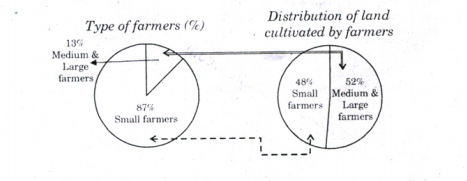
Answer: 1) Majority of land (52%) which is used for farming activities is under the control of mere 13%, consisting of medium and large farmers.
2) 87% of farmers, consisting of small farmers control just 48% of the land used for farming activities.
3) The above numbers clearly indicates that the land distribution for farming activities is highly unequal. These numbers demonstrate the income inequality among farmers.
4) The above numbers suggest that the land reforms undertaken by the Government has not succeeded in bringing equality among farmers.
8. Explain the effects of globalisation in India?
Answer: The effects of globalisation in India are:
- The growth of foreign investment is enormous in the country in all sectors of development.
- Has a tremendous impact on the social, monetary, cultural and political area.
- Due to improvements in transportation and information technology, globalisation has taken a giant leap.
- With the opportunity of Special Economic Zones (SEZ), there is an increase in the number of new job opportunities.
- Due to the skill and knowledge a foreign company offers, the Indian firms are increasing the compensation which indirectly has a positive impact on globalisation.
- The Indian economy and the standard of living of an individual has increased.
- Many cities are undergoing a better standard of living along with business development and improving the class of their lifestyle.
9. How does organic farming promote biodiversity?
Answer: Organic farming seeks to establish a sustainable management system for agriculture with respect to nature’s systems and cycles. It also sustains and enhances the health of soil, water, plants and animals and the balance between them, and contributes to a high level of biological diversity. Organic farming systems generally harbour larger floral and fauna biodiversity. In this way, organic farming promotes diversity.
10. (A) Describe the Indian Islands
OR
(B) “We should be able to integrate environmental concerns with the idea of progress”. Explain.
Answer A: The Indian Mainland includes two groups of islands, i.e. Andaman & Nicobar Islands and Lakshadweep Islands. The former is situated in the Bay of Bengal and the latter is found in the Arabian Sea. Andaman & Nicobar Islands are a group of 572 islands with its capital city as Port Blair, whereas Lakshadweep islands are a group of 36 islands with its capital as Kavaratti. Other than these two main groups India has a large number of islands.
Answer B: Environment also absorbs and renders harmless waste and pollution from various activities. Unwanted byproducts of production and consumption like exhaust gases from consumption, water that is used to clean products, discarded packaging and goods that are no longer wanted are absorbed by the environment. This is the reason why we should be able to integrate environmental concerns with the idea of progress.
11. (A) Read the given para and answer the question given below.
Most scientists from around the world agree on this much: AGW is real, it is happening, and it is leading to rapid and drastic climate change. They warn that severe weather and other changes will increase in the coming years. One of the human activities that contribute to global warming is deforestation.
Q: Read the text given above and comment on climate change.
OR
(B) When families migrate, children accompanying their parents do not have creche facilities. Grown-up children are not able to continue their studies at their parents’ new workplaces. Schools in their native place refuse to take them again. when they come back. They finally become dropouts. When males leave their families this is also a major challenge for women who have to take care of all the responsibilities of the family and elderly people who need care. Young girls in such families are required to take care of siblings and many of them become dropouts.
Q: “Most of the children of migrant families become dropouts” – Comment.
Answer A: Climate change refers to the regional and global change in climatic patterns. It can be caused by various human activities. When climate change occurs it leads to a rise in temperature and other major changes. Moreover, it may result in intense rain, flood, and drought. Nowadays, due to climate change, glaciers and oceans have undergone severe changes. The oceans are becoming more toxic and due to the melting of glaciers, there is a rise in sea level.
Due to the human activities which produce a large amount of carbon dioxide and other greenhouse gases, climate change occurs. In order to produce energy, fossil fuels are burned which produces most of the harmful gases. To prevent the earth from warming, greenhouse gases act as a blanket to the earth. In the last century, global warming has taken up its effect in great amounts.
Answer B: I do agree. It is true that most of the migrant family’s children become drop-out either due to parents fault or due to the children’s fault. The reasons for the statement are:
- Migrant families feel like to readmit their children. Instead, they take them to their working sites and make them as their companion for their work, with a motive of earning more money.
- When they migrate due to agricultural failure and in search of new jobs. This condition makes the family survive; therefore children cannot afford education due to the family situation.
- Higher education schooling facilities may not be available in the locality. Parents feel unsafe to send their children far and make them study, which is also time-consuming.
- It takes a lot of time for the children to adjust to the environment and if they don’t take up well with the people, it may result in depression. Depression reduces the concentration in studies and makes them drop out.
12 A: Study the graph and answer the following questions.
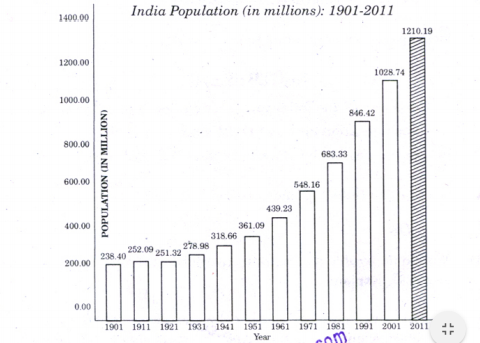
(1) In which year, did the population decrease?
(2) For how many years census been held regularly?
(3) Why was the population of India increasing after independence?·
(4) What problems would arise with the population explosion?
OR
(B) Plot the below information on a bar graph. Write your observation.

Answer A 1: The population declined in the year 1921.
Answer 2: For 12 years census has been held regularly.
Answer 3: The population of India increased after Independence because of the following reasons.
- The rise in population can be attributed to an increase in the birth rate. In India, birth rates have always been on a higher side, due to lack of awareness of family planning, illiteracy.
- There has been a decline in the death rates due to better health facilities, etc.
- Increased migration has largely impacted the composition and distribution of the population.
- Internal migration from rural to urban areas in search of better employment opportunities have increased the population of cities and towns.
Answer 4: Population explosion gives rise to a number of social problems. It leads to the migration of people from rural areas to the urban areas causing the growth of slum areas. People live in most unhygienic and insanitary conditions. Unemployment and poverty lead to frustration and anger among the educated youth.
Answer B: The answer for this question will be answered soon.
13. Mark the following in the given outline map of India.
(A)
(1) Himachal Pradesh.
(2) River Tungabhadra.
(3) Aravalli ranges.
(4) Indira Point.
OR
(B)
(1) The highest peak in India.
(2) Islands of volcanic origin
(3) Saltwater lake in Andhra Pradesh.
(4) The state with a low-density population.
Answer: Activity to be done by yourself.
14. Which of the following statements is correct, related to Indian rivers?
(i) Himalayan rivers are perennial rivers.
(ii) Godavari and Krishna are peninsular rivers.
(iii) All the Indian rivers originate from the Himalayas.
(A) (i) only
(B) (i) and (ii)
(C) iii only
(D) (i), (ii) and (iii)
Answer: B
15. The people who are mainly benefited by Globalization.
(1) Rich consumers.
(2) Skilled and educated people.
(3) Farmers.
(4) Poor people.
(A) 1 and 2
(B) 3 and 4
(C) 1 and 3
(D) 1 and 4
Answer: A
16. Who supply food products to low-income groups?
(A) Multinational Companies.
(B) World Health Organisation.
(C) Public Distribution System.
(D) World Bank.
Answer: C
17. The aim of WTO is …..
(A) To liberalise International trade.
(B) To impose barriers to foreign investment.
(C) To discourage globalization.
(D) To favour the backward countries.
Answer: A
18. Based on which factor among the following, a state can be mentioned as a backward state?
(A) High infant mortality rate.
(B) Low literacy rate.
(C) Low net attendance rate.
(D) All the above.
Answer: D
19. Thar desert is situated in the leeward side of which mountains?
(A) Himalayas
(B) Vindhya
(C) Satpura
(D) Aravalli
Answer: D
20. GDP is the total value of …….
(A) AlI the services.
(B) All intermediate goods.
(C) All final goods.
(D) Both A and B.
Answer: C
21. Which among the following countries is in a better position according to the Human Development Index 2013?
(A) Nepal
(B) Pakistan
(C) Myanmar
(D) Srilanka
Answer: D
22. Which of the following sentences is wrong?
(A) Tropical regions are nearer to the equator.
(B) Temperature increases as altitude increases.
(C) Intensity of temperature depends on the latitude.
(D) As we move away from the equator towards the poles temperature decreases.
Answer: B
23. Who among the following belong to the unorganised sector?
(A) Bank employees
(B) Government teachers
(C) Agricultural labourers
(D) Railway employee.
Answer: C
24. Himalayan rivers are called Perennial because …….
(A) they provide a livelihood to Indians.
(B) they flow throughout the year.
(C) they help farming.
(D) many tributaries join them.
Answer: B
25. Tools, Machines, Buildings are called in the Production process as.
(A) Working Capital.
(B) Fixed Capital.
(C) A and B.
(D) None.
Answer: B
26. The first state that follows organic farming in India is …….
(A) Punjab
(B) Kerala
(C) Sikkim
(D) Meghalaya
Answer: C
27. Find the mismatch
(A) Rajiv Gandhi International airport – Hyderabad.
(B) Indira Gandhi International airport· – Kolkata.
(C) Suvarna Bhoomi International airport – Bangkok.
(D) Heathrow airport – London.
Answer: B
28. The south Indian rivers are flowing towards the east because …….
(A) The Bay of Bengal is located in the East.
(B) Their origin is in the Eastern Ghats.
(C) Deccan plateau is slanting towards the east.
(D) They are not perennial.
Answer: A
29. The criteria are taken by UNDP as a standard to measure development …….
(A) Migration
(B) Health status of people.
(C) Per Capita Income
(D) Both B and C.
Answer: D
Observe the map given below and answer the questions. 30 and 31.
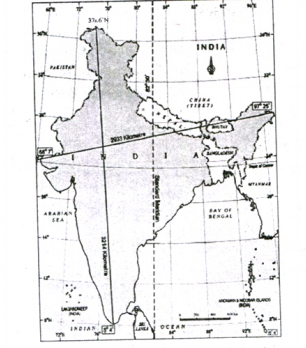
30. The country that doesn’t share its land boundary with India.
(A) Nepal
(B) China
(C) Srilanka
(D) Pakistan
Answer: C
31. The line that divides India into almost two equal halves.
(A) Tropic of Cancer.
(B) Tropic of Capricorn.
(C) The Equator.
(D) Greenwich longitude.
Answer: A
32. Which among the following measures help to control global warming?
(A) Growing trees.
(B) Following Organic farming.
(C) Utilising Public Transport.
(D) All the above.
Answer: D
33. The main tool that can reduce gender discrimination.
(A) Health.
(B) Marriage
(C) Education.
(D) Migration.
Answer: C
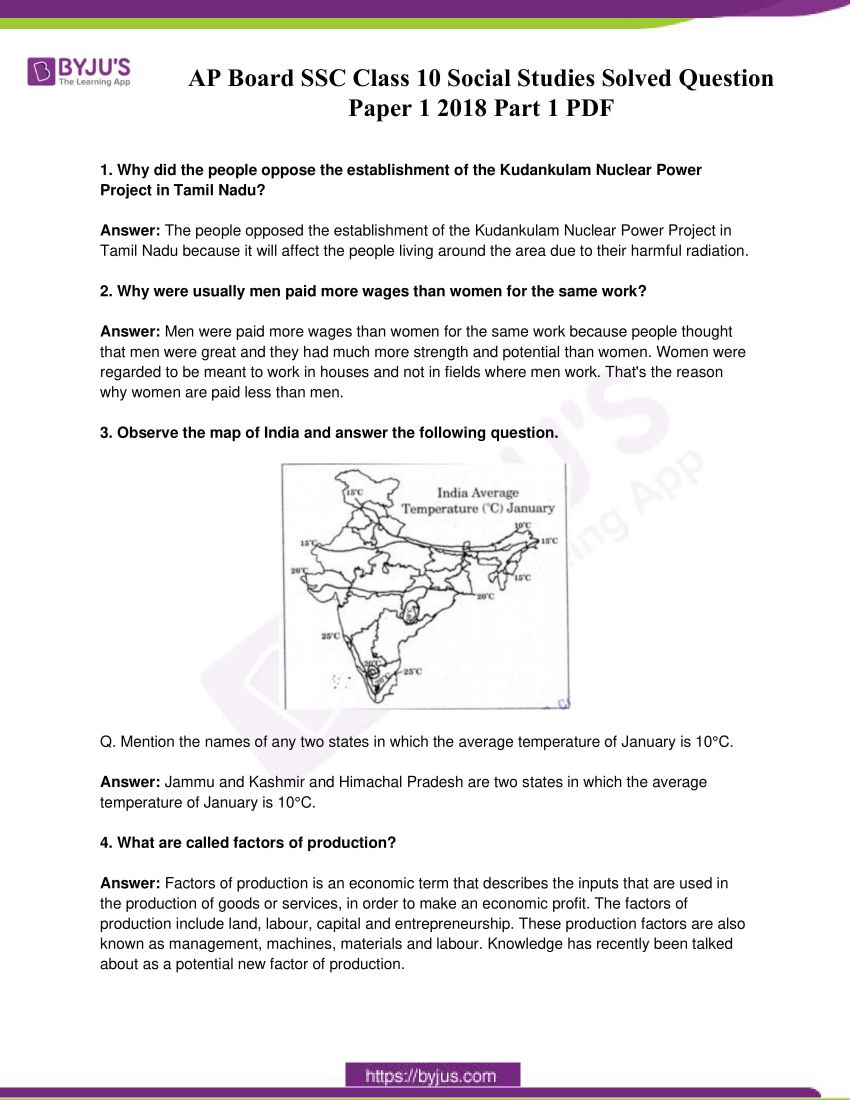
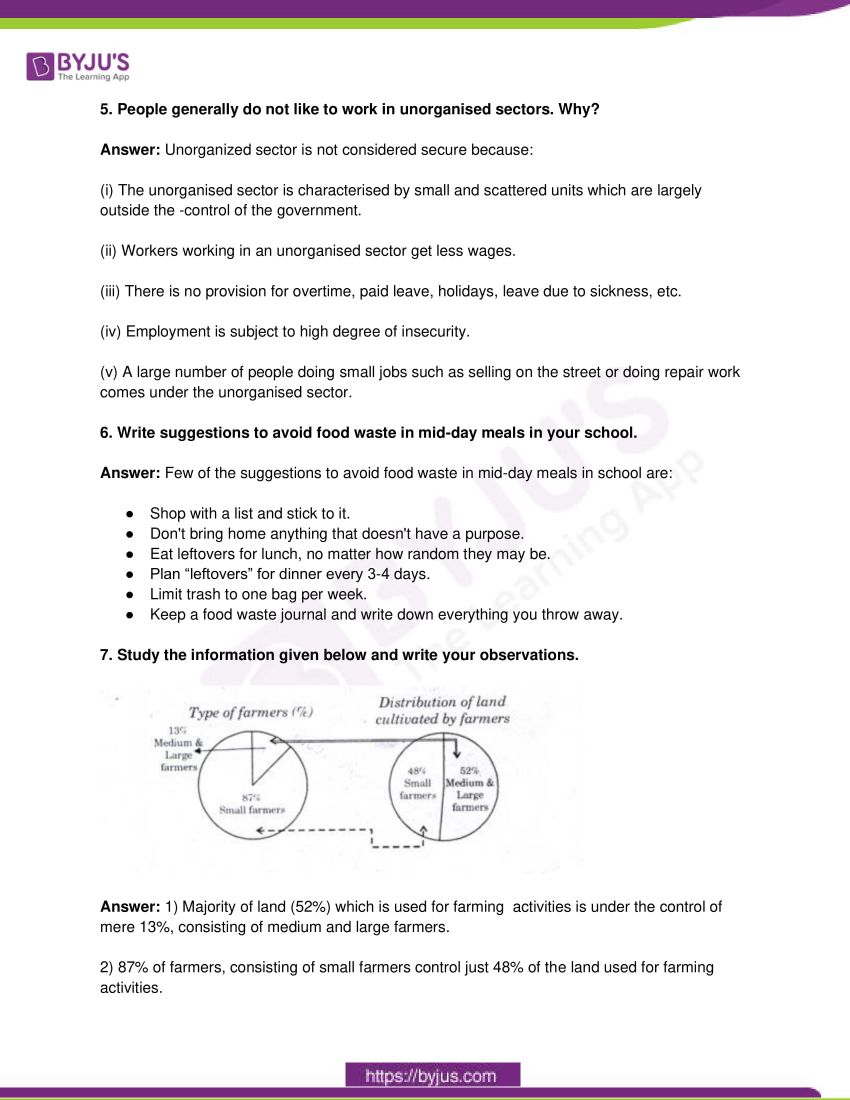
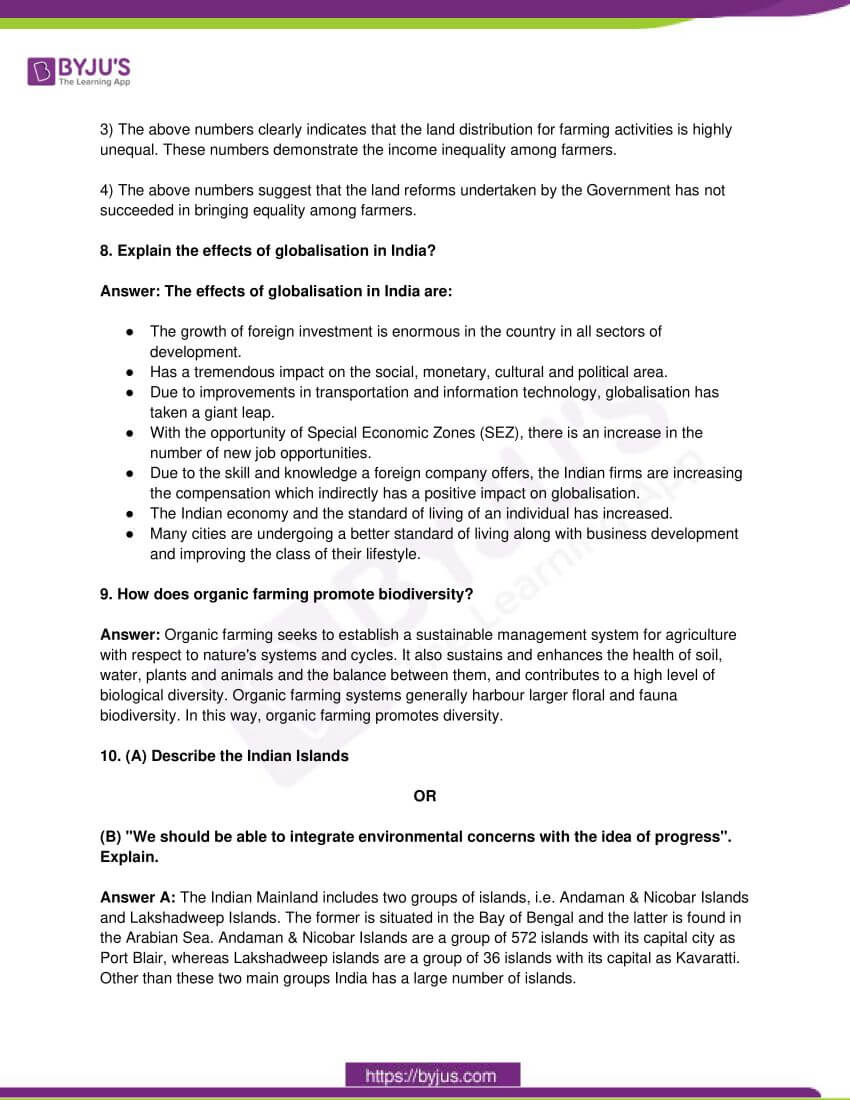
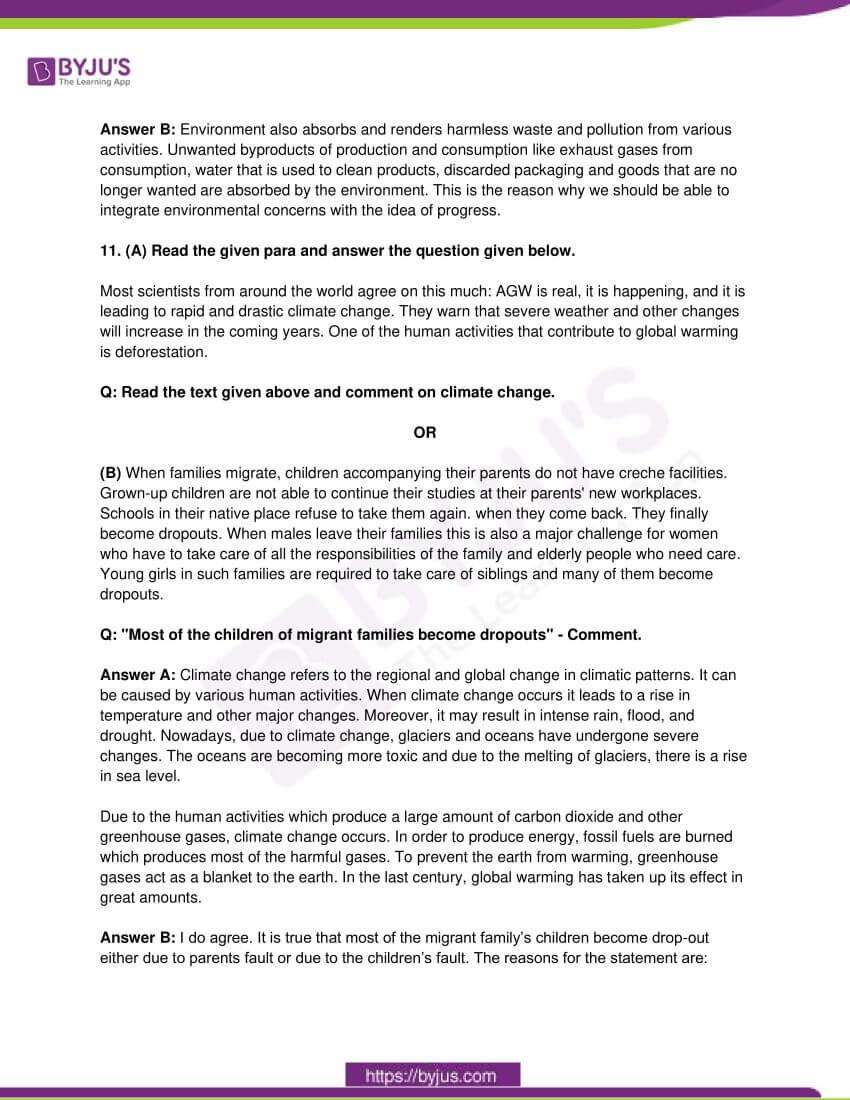
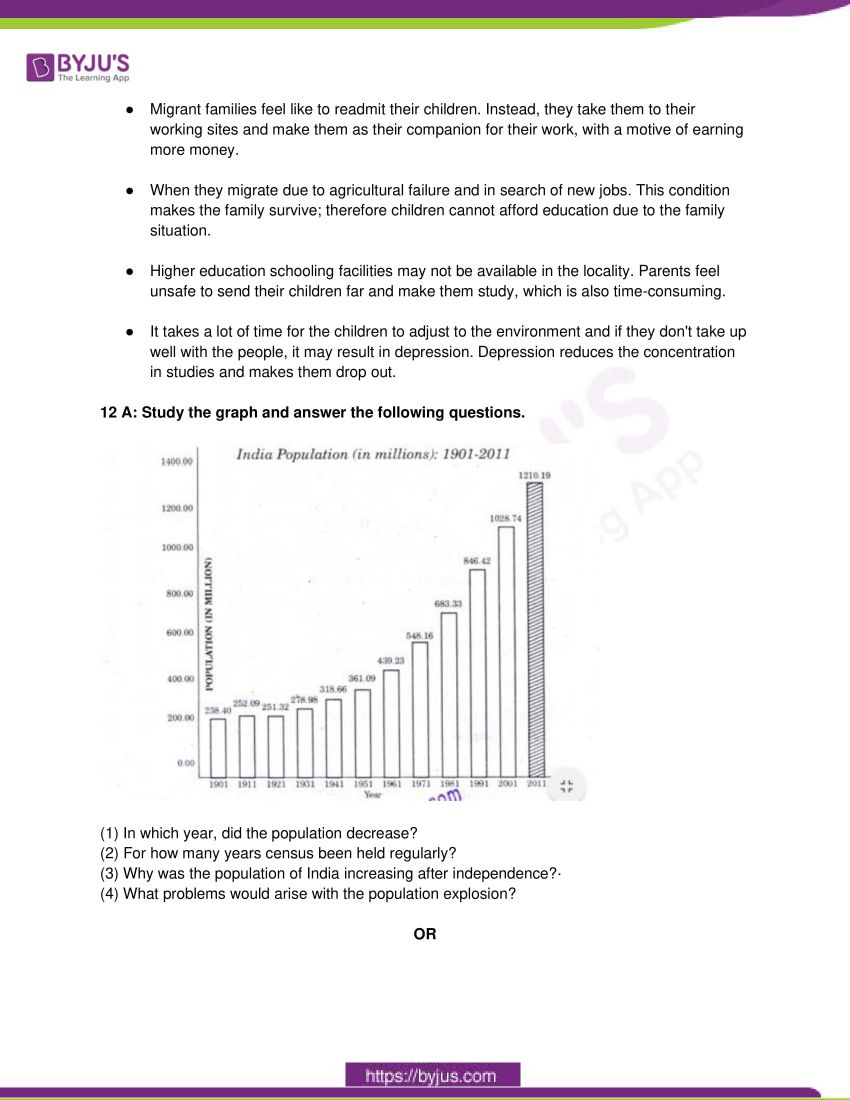
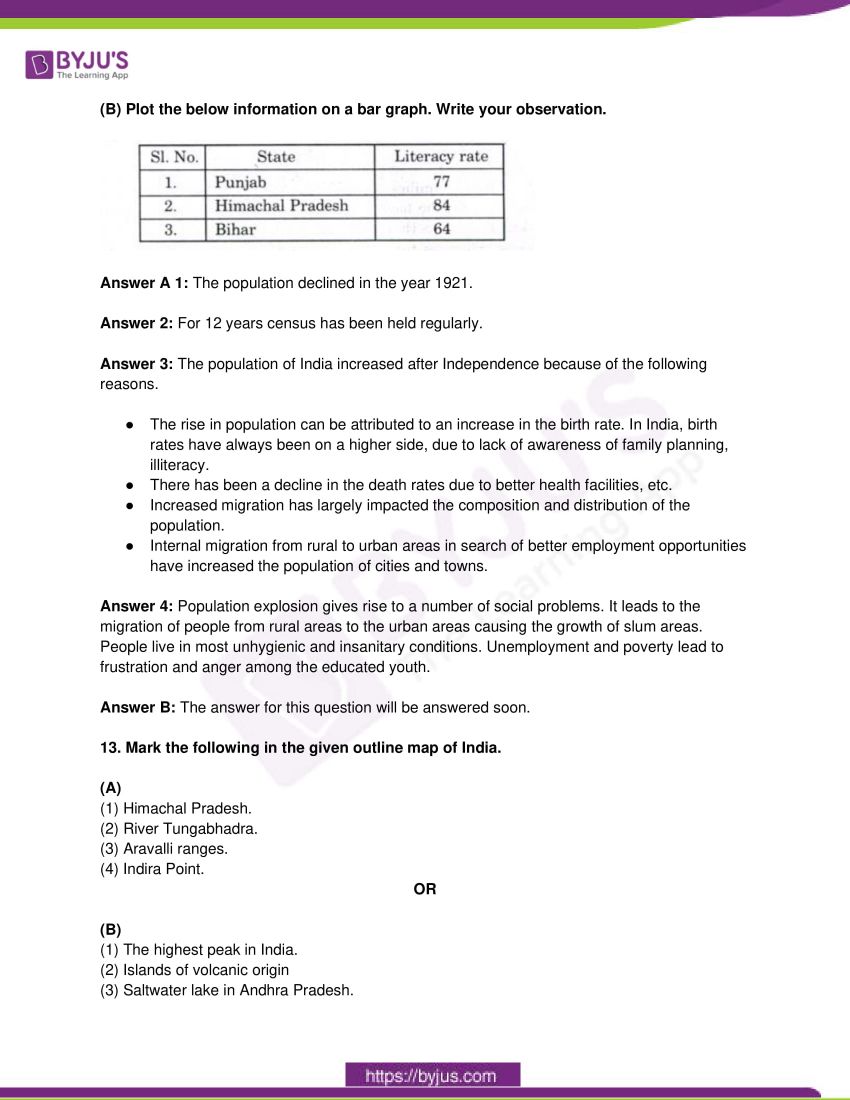
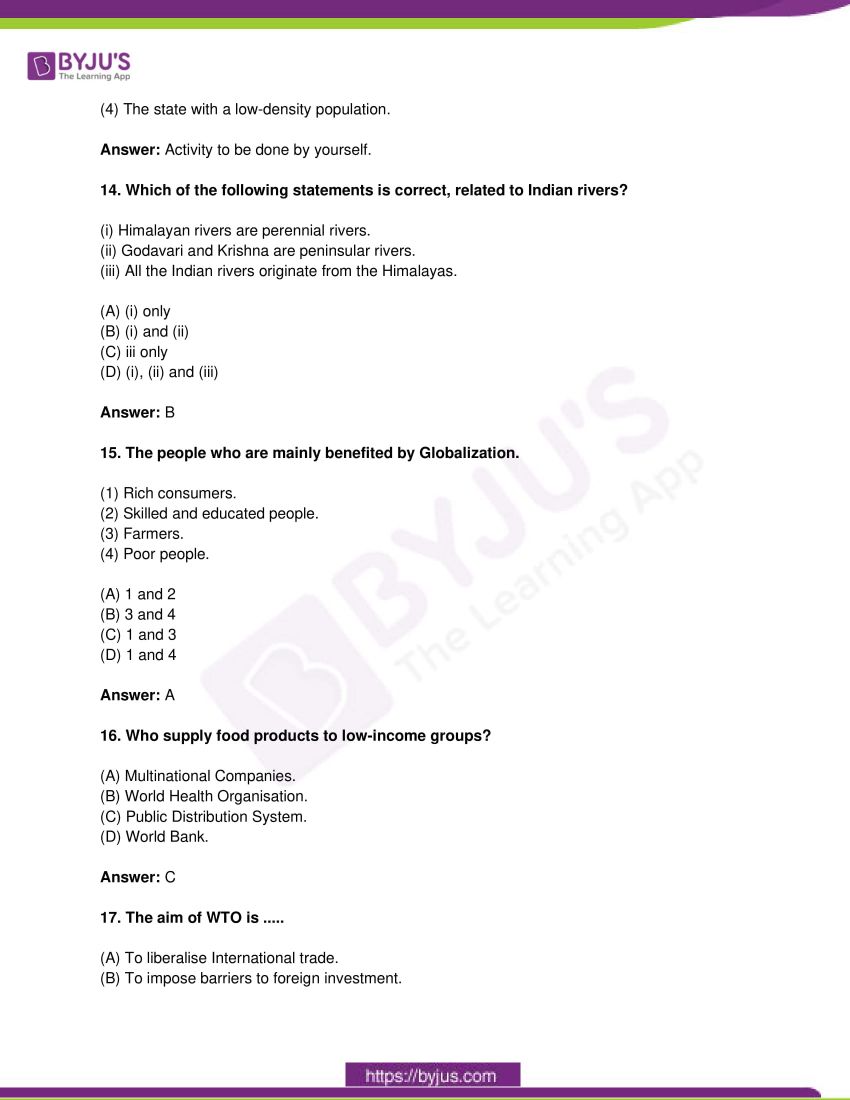
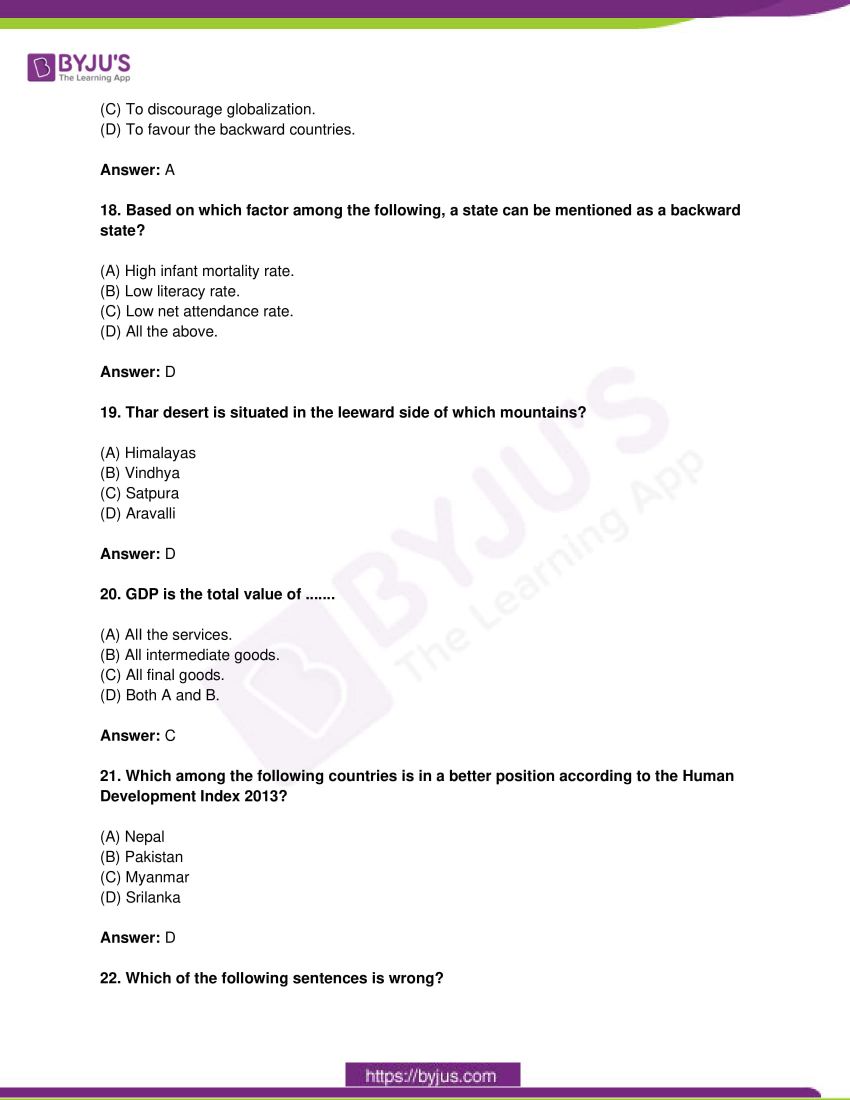
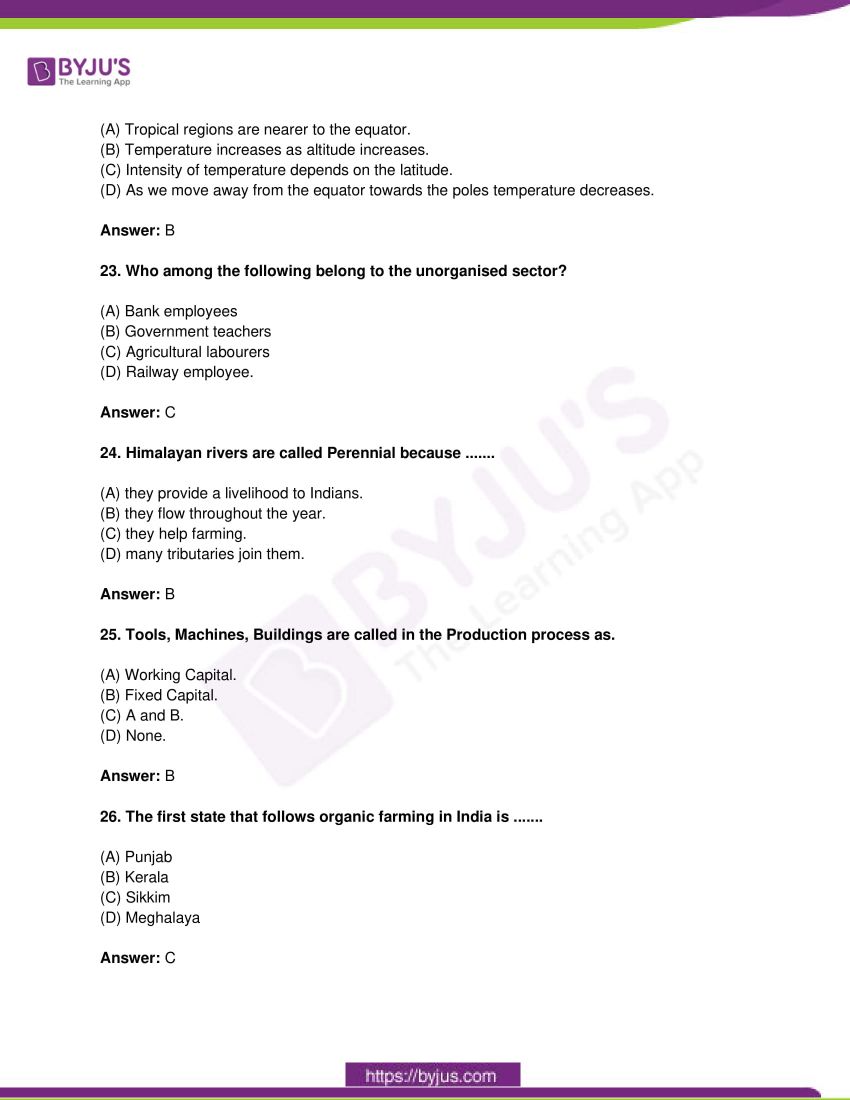
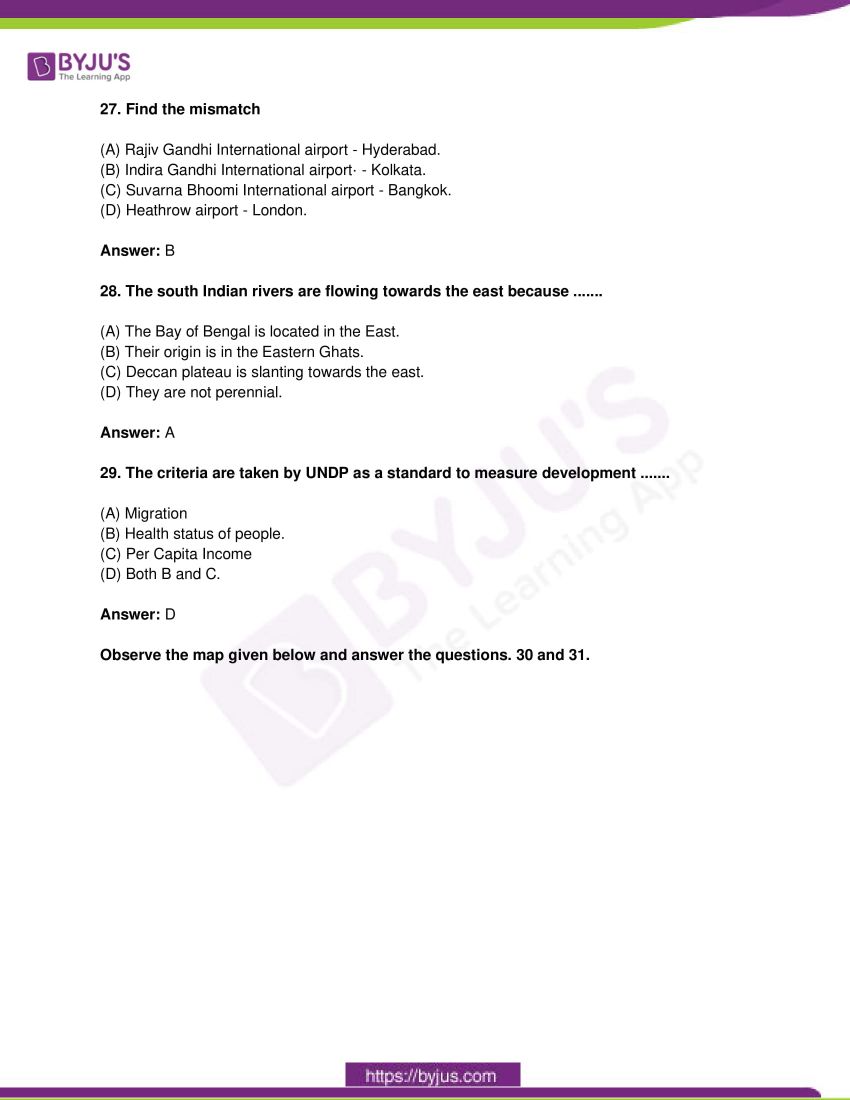
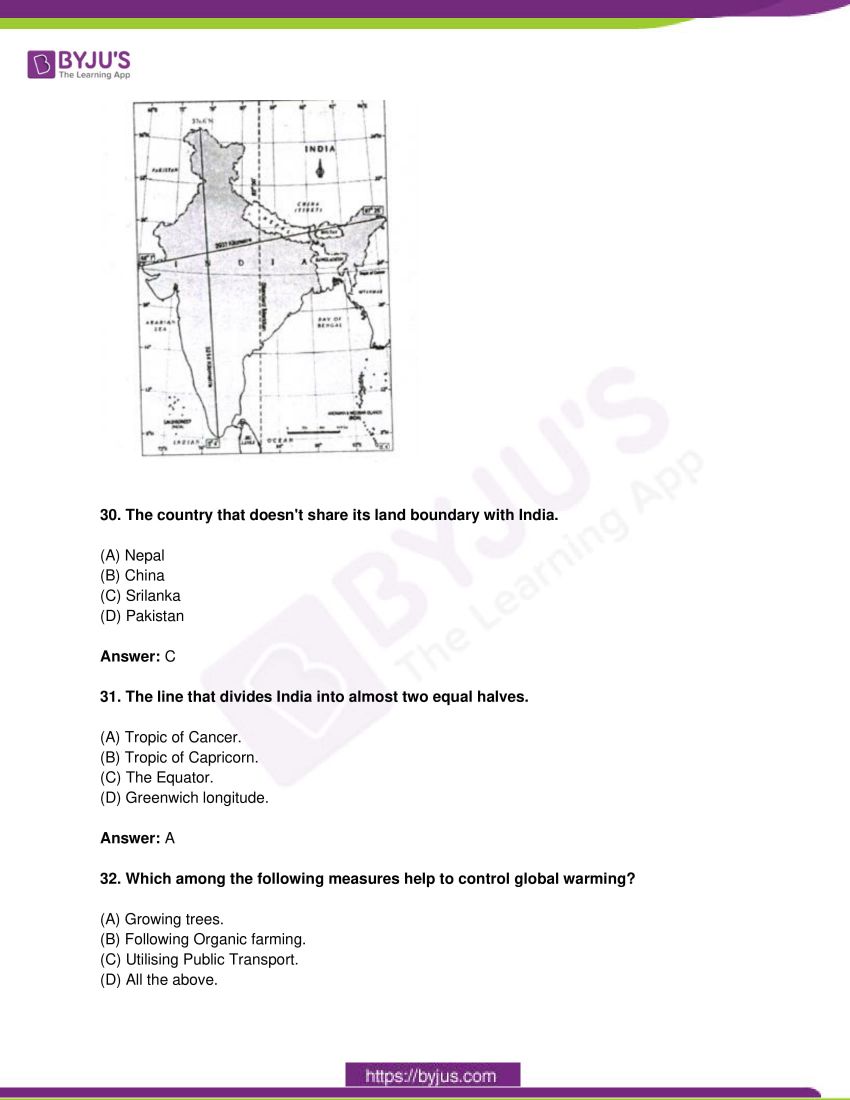

Comments